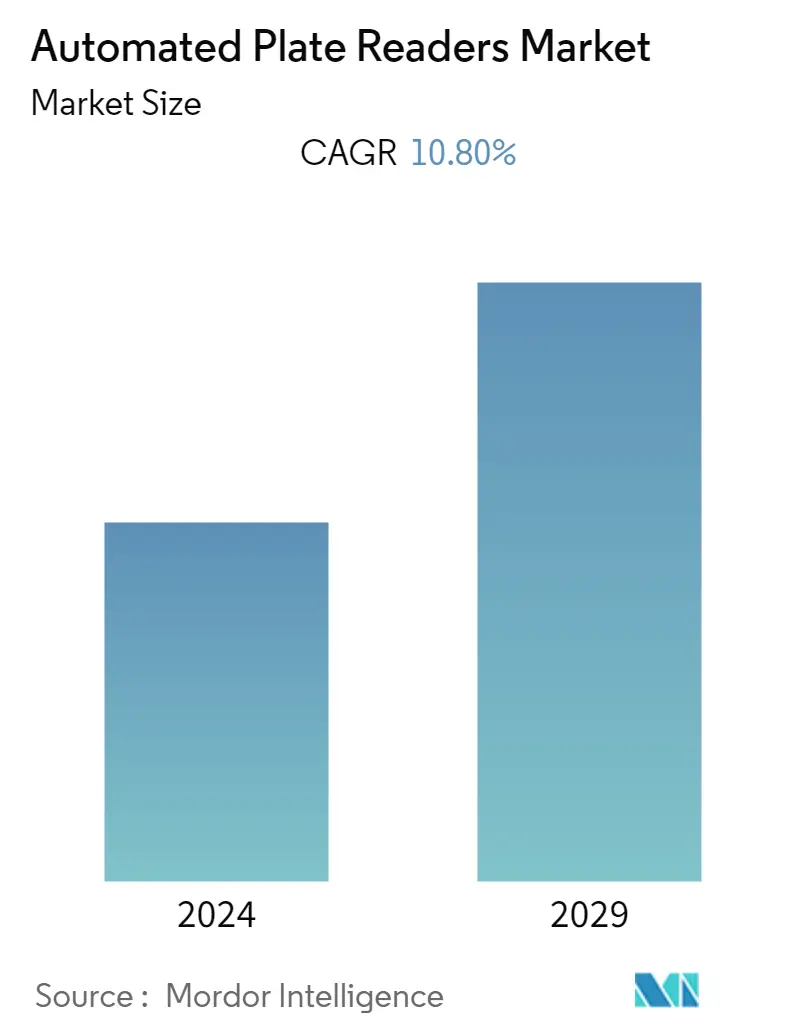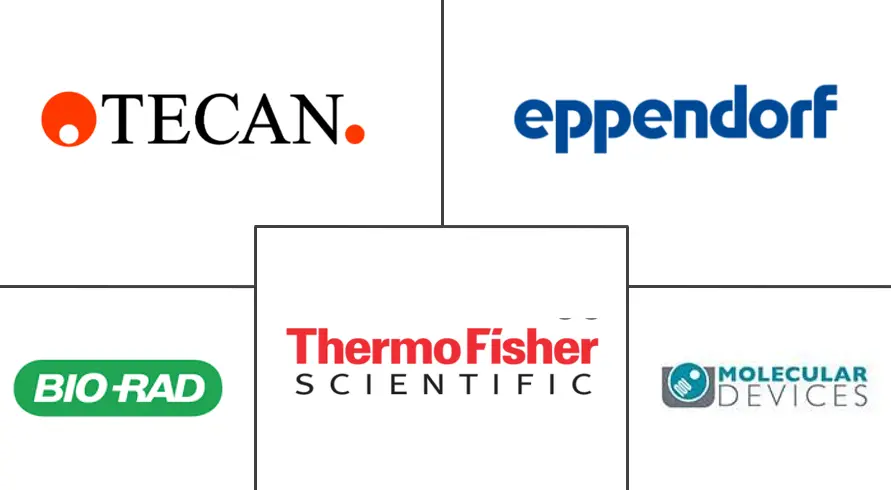| Study Period | 2019 - 2029 |
| Base Year For Estimation | 2023 |
| Forecast Data Period | 2024 - 2029 |
| CAGR | 10.80 % |
| Fastest Growing Market | Asia Pacific |
| Largest Market | North America |
| Market Concentration | Low |
Major Players*Disclaimer: Major Players sorted in no particular order |
Automated Plate Readers Market Analysis
The automated plate readers market is expected to grow at a CAGR of 10.8% over the forecast period (2021 - 2026).
Besides the need for a profound understanding of SARS-CoV-2 biology and for the swift development of treatments, the COVID-19 outbreak focused significant efforts on the development of diagnostic methods to identify infected individuals. The Automated Systems from Berthold Technologies allow unattended automation of most microplate-based assays.
- The operational and strategic needs of labs are continually changing, evolving, and expanding. The adoption of a new laboratory automation solution utilizes a workflow analysis and offers benefits to laboratories to a large extent. A workflow study will provide lab leaders with a transparent and data-driven picture of what the laboratory is doing right now.
- This is where comes the role of automated plate readers which are plate readers for quantifying protein and other activities, via a specific light source connected through an optical filter, for analyzing the sample. Fluorescence detection is developed for detecting microplate. It is more expensive than absorbance detection. In the pattern for fluorescence detection, the sample undergoes illumination through two optical systems.
- The need for flexibility and adaptability in a laboratory is driving more number of laboratories to look for solutions that will help in growing their panel selections in diagnostic systems, along with the ability to offer flexibility to third-party providers.
- The market is witnessing an increase in investments from government agencies and private organizations to finance the R&D activities in small companies striving to advance their initial discoveries to commercial development. For instance, the Department of Health and Human Services' Small Business Innovation Research and Small Business Technology Transfer programs provide financial assistance to small companies endeavoring to advance their primary discoveries to commercial development. However, the major challenge for automated plate readers is to interconnect various platforms across the lab.
Automated Plate Readers Industry Segmentation
An automated plate reader is a device to detect chemical, biological, or physical reactions by hitting them with light and then measuring its characteristics since every element solid or liquid emits different characteristics when being hit by the light. The market study comprises of Product Type, Application and Geography.
| Dedicated Microplate Readers (Single-mode Readers) |
| Multimode Microplate Readers |
| Drug Discovery |
| Genomics and Proteomics Research |
| Clinical Diagnostics |
| Other Applications |
| North America |
| Europe |
| Asia Pacific |
| Rest of the World |
Automated Plate Readers Market Size Summary
The automated plate readers market is experiencing significant growth, driven by the increasing need for laboratory automation solutions that enhance efficiency and accuracy in diagnostics and clinical research. These systems, which utilize advanced technologies such as fluorescence and absorbance detection, are becoming essential in laboratories seeking to expand their diagnostic capabilities and streamline workflows. The demand for flexible and adaptable solutions is further fueled by the ongoing advancements in biotechnology and life sciences, where automated plate readers play a crucial role in drug discovery and development. The market is characterized by substantial investments from both government and private sectors, supporting research and development activities aimed at advancing these technologies.
In North America, the market landscape is highly dynamic, with numerous mergers and acquisitions and significant contributions from the United States. The region's focus on drug discovery, particularly in areas like GPCR-targeting drugs, underscores the potential for automated plate readers to drive innovation in therapeutics. Regulatory frameworks, such as those imposed by the FDA, are also shaping market growth by ensuring the safety and effectiveness of these devices. Major players in the market, including Thermo Fisher Scientific, Tecan Group Ltd, and Bio-Rad, are actively engaged in research and development to maintain competitive advantage. The introduction of new products, such as portable microplate readers and advanced assay technologies, highlights the ongoing evolution and expansion of the automated plate readers market.
Automated Plate Readers Market Size - Table of Contents
1. MARKET DYNAMICS
- 1.1 Market Overview
- 1.2 Assessment of Impact of COVID-19 on the Market
-
1.3 Market Drivers
- 1.3.1 Increasing R&D Expenditure in the Pharmaceutical Industry and Growing Demand from Drug Discovery and Genomics
- 1.3.2 Technological Advancement (Launch of Products with New Features)
-
1.4 Market Restraints
- 1.4.1 High Cost of Microplate Systems
- 1.5 Industry Value Chain Analysis
-
1.6 Industry Attractiveness - Porter's Five Force Analysis
- 1.6.1 Threat of New Entrants
- 1.6.2 Bargaining Power of Buyers/Consumers
- 1.6.3 Bargaining Power of Suppliers
- 1.6.4 Threat of Substitute Products
- 1.6.5 Intensity of Competitive Rivalry
-
1.7 Technology Snapshot (Detection Modes)
- 1.7.1 Absorbance
- 1.7.2 Fluorescence
- 1.7.3 Luminescence
- 1.7.4 Time-resolved Fluorescence
- 1.7.5 Fluorescence Polarization
- 1.7.6 Light Scattering
2. MARKET SEGMENTATION
-
2.1 By Product Type
- 2.1.1 Dedicated Microplate Readers (Single-mode Readers)
- 2.1.2 Multimode Microplate Readers
-
2.2 By Application
- 2.2.1 Drug Discovery
- 2.2.2 Genomics and Proteomics Research
- 2.2.3 Clinical Diagnostics
- 2.2.4 Other Applications
-
2.3 Geography
- 2.3.1 North America
- 2.3.2 Europe
- 2.3.3 Asia Pacific
- 2.3.4 Rest of the World
Automated Plate Readers Market Research FAQs
What is the current Automated Plate Readers Market size?
The Automated Plate Readers Market is projected to register a CAGR of 10.8% during the forecast period (2025-2030)
Who are the key players in Automated Plate Readers Market?
Bio-Rad Laboratories, Eppendorf AG, Tecan Group Ltd, Thermo Fisher Scientific and Molecular Device LLC are the major companies operating in the Automated Plate Readers Market.




